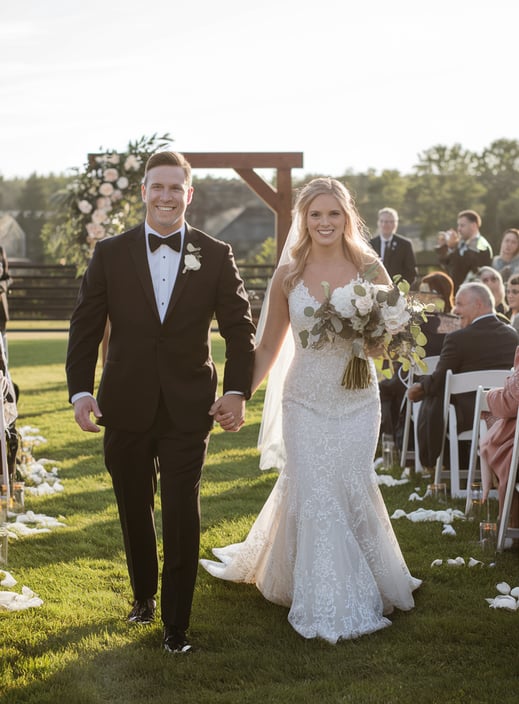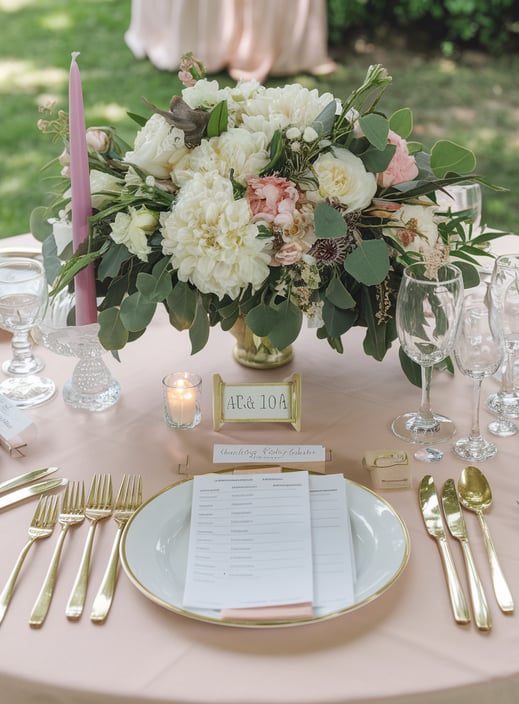How to Create the Perfect Wedding Day Timeline
Toast With Ease
11/26/20244 min read


Planning a wedding can feel overwhelming, but having a well-structured timeline is the key to a stress-free and memorable day. A thoughtfully planned schedule ensures that everything runs smoothly, from getting ready in the morning to dancing the night away at the reception. Whether you’re working with a wedding planner or coordinating the day yourself, a wedding day timeline is a must.
In this guide, we’ll break down everything you need to know about creating a detailed wedding day timeline, including tips, tricks, and sample schedules to keep you on track.
Why You Need a Wedding Day Timeline
The wedding day is a whirlwind of activities, emotions, and moments you’ll want to cherish. Without a timeline, it’s easy for things to get delayed, causing unnecessary stress. Here are some key reasons why a timeline is essential:
Stay Organized: A timeline ensures that every task, from hair and makeup to the first dance, is accounted for.
Keep Vendors on Track: Your photographer, caterer, and other vendors will rely on the timeline to know when and where they need to be.
Avoid Delays: With a clear schedule, you’ll minimize the chances of running late and feeling rushed.
Maximize Enjoyment: A timeline allows you to fully enjoy each moment, knowing everything is running smoothly.
Steps to Create a Wedding Day Timeline
1. Start with Your Ceremony Time
The ceremony is the focal point of your wedding day, so everything else will revolve around it. Begin by determining the time of your ceremony and work backward to plan the pre-ceremony activities, and forward to schedule the reception events.
For example:
Ceremony Time: 4:00 PM
Plan pre-ceremony activities (hair and makeup, first look, photos) leading up to 4:00 PM.
Plan reception activities (cocktail hour, dinner, speeches, dancing) after the ceremony.
2. Consider the Duration of Key Events
Estimate how long each activity will take and allocate sufficient time for it. Here’s a general guide:
Hair and Makeup: 2–3 hours (add extra time if there’s a bridal party)
Getting Dressed: 30 minutes
First Look Photos: 30–45 minutes
Family Photos: 30 minutes
Ceremony: 30–60 minutes
Cocktail Hour: 1 hour
Reception (Dinner, Speeches, Dancing): 4–5 hours
Be realistic about how much time is needed, and always add a buffer to account for unexpected delays.
3. Build In Buffer Time
Wedding days rarely go exactly as planned, so it’s crucial to build in extra time between activities. For instance:
Hair and Makeup: Add 30 extra minutes in case someone runs late.
Travel: If your ceremony and reception are at different locations, allow extra time for transportation.
Photos: Photographers often need more time to set up the perfect shots, so don’t rush this step.
Having buffer time ensures that small delays don’t throw off your entire schedule.


4. Communicate with Vendors
Your vendors play a critical role in your wedding day, so it’s important to share the timeline with them. Discuss the following:
Photographer: Confirm the time they’ll arrive, when group photos will be taken, and any special shots you want.
Hair and Makeup Artist: Provide a detailed schedule for who gets ready when.
Caterer: Confirm when food and drinks will be served during the reception.
Collaboration with vendors will help refine the timeline and ensure everyone is on the same page.
5. Prioritize Key Moments
Every couple has different priorities for their wedding day. Identify the moments that matter most to you and make sure they’re scheduled with care. Examples might include:
First Look: If you’re having a first look, allocate time for an intimate moment before the ceremony.
Special Dances: Include time for the first dance, parent dances, and any other traditions.
Sunset Photos: Check the sunset time and schedule time for romantic golden-hour shots.
6. Plan for Guest Experience
Your guests’ experience is an important consideration. Keep in mind:
Avoid long waiting times between the ceremony and reception.
Provide entertainment, drinks, or snacks during cocktail hour.
Ensure the transitions between events are smooth to keep guests engaged.
Happy guests make for a more enjoyable celebration!
Sample Wedding Day Timeline
Here’s an example of a wedding day timeline for a 4:00 PM ceremony:
7:00 AM: Wake up and enjoy a light breakfast.
7:30 AM – 10:30 AM: Hair and makeup for the bridal party.
10:30 AM – 11:00 AM: Bride gets into her dress.
11:00 AM – 12:00 PM: First look photos with the groom.
12:00 PM – 1:00 PM: Bridal party and family photos.
1:00 PM – 2:00 PM: Lunch break and touch-ups.
2:00 PM – 3:30 PM: Travel to the ceremony venue and relax before the ceremony.
4:00 PM – 4:30 PM: Ceremony begins.
4:30 PM – 5:30 PM: Cocktail hour and couple’s portraits.
5:30 PM – 6:00 PM: Guests transition to the reception area.
6:00 PM – 7:30 PM: Dinner is served, and speeches take place.
7:30 PM – 8:00 PM: First dance and parent dances.
8:00 PM – 11:00 PM: Open dance floor, cake cutting, and bouquet toss.
11:00 PM: Send-off for the couple.
Tips for a Seamless Wedding Day
Delegate Tasks: Assign a trusted friend, family member, or wedding planner to oversee the timeline and handle any issues that arise.
Have a Printed Timeline: Share printed copies with key members of the wedding party and vendors.
Stay Flexible: Things might not go perfectly, and that’s okay! Focus on enjoying the day rather than stressing over small delays.
Plan for Unexpected Issues: Pack an emergency kit with items like safety pins, tissues, and snacks to handle any last-minute hiccups.
Conclusion
Creating a wedding day timeline is one of the most important steps in planning your big day. A well-organized schedule ensures that everything runs smoothly, allowing you to focus on the joy of celebrating with your loved ones.
By starting with your ceremony time, estimating the duration of key events, building in buffer time, and communicating with vendors, you’ll create a timeline that minimizes stress and maximizes enjoyment. Remember to prioritize the moments that matter most, and don’t forget to add your personal touch to make the day uniquely yours.
With a solid timeline in place, your wedding day will be a celebration to remember!
© 2024 ToastWithEase. All rights reserved.


